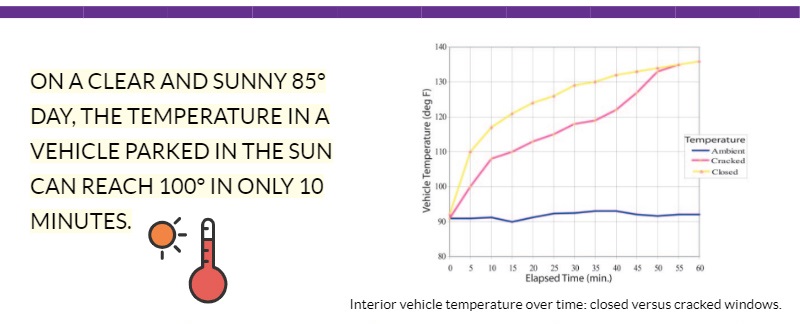Heatstroke kills children in cars every year. But hot car deaths are preventable!
The Problem


Interior Vehicle Temperature Over Time: Closed Versus Cracked Windows

The Problem: Children Are Dying Preventable Deaths in Cars
Since 1990, more than 1,000 children have died from hyper/hypothermia after being left in a car. While over half these children were forgotten in the car accidentally, the rest were abandoned intentionally by parents who underestimated the risk of their actions.
Anyone charged with watching a young child should remember: overheating in a car is deadly, and happens faster than most of us think. On a clear and sunny 85° day, the temperature in a vehicle that is parked in the sun can reach 100° in only 10 minutes.
“Heatstroke occurs when a person’s temperature exceeds 104° and their thermoregulatory mechanism is overwhelmed. A core body temperature of 107° is considered lethal as cells are damaged and internal organs shut down. Small children’s thermoregulatory systems are not as efficient as an adult’s and their body temperatures rise at a rate 3 to 5 times faster than an adult’s.”
This means that a child can suffer from heatstroke in a matter of minutes.
Even the Government Wants to Help, But So Far, No Luck.
Everyone realizes that there is a problem. Even the government has attempted to introduce legislation to protect the children, but unfortunately, there is still not a viable, enforceable solution.
- Recently, the S. House of Representatives introduced and passed the Hot Cars Act of 2017. This bill requires that all new passenger vehicles sold must be equipped with technology that will provide an alert when a child or unattended passenger remains in the rear seat after the vehicle’s motor has been deactivated. Sadly, this has not been as all-encompassing as many would hope. An exact version of the House Hot Cars Act was also introduced in the Senate, but was not taken up.
- The Hot Cars Act has been introduced in both chambers in the 117th Congress.
Most significantly, these complex reminder solutions may well be less than satisfactory in addressing pediatric vehicular heatstroke. “Safety belt reminders are a lesson in how easy it is to ignore activators.”
Furthermore, exiting a vehicle without the ignition key and windows closed frequently results in drivers locked out of their vehicle. The security system, working as intended or defectively, acts autonomously to lock the vehicle. If a child is left “trapped” inside with rising temperature, the driver’s only rapid response is to bash in a window. Our “Three Rs” solution unlocks doors and opens the windows immediately. Learn about the 3 R’s here.
What Areas Aren’t Being Serviced?
These governmental actions are a step forward, but they are not enough. What is needed is a sweeping industry-wide solution.
- Car seat manufacturers and car companies need an easy-to-use technology that works seamlessly.
- It shouldn’t be expensive or require major alteration to a vehicle.
Unfortunately, most of the ideas proposed or implemented are not as comprehensive as they can or should be.
A few minutes can mean the difference between life and death. The answer is hiding in plain sight. We just have to get past the notion that opening car windows endangers the child inside without exception.

